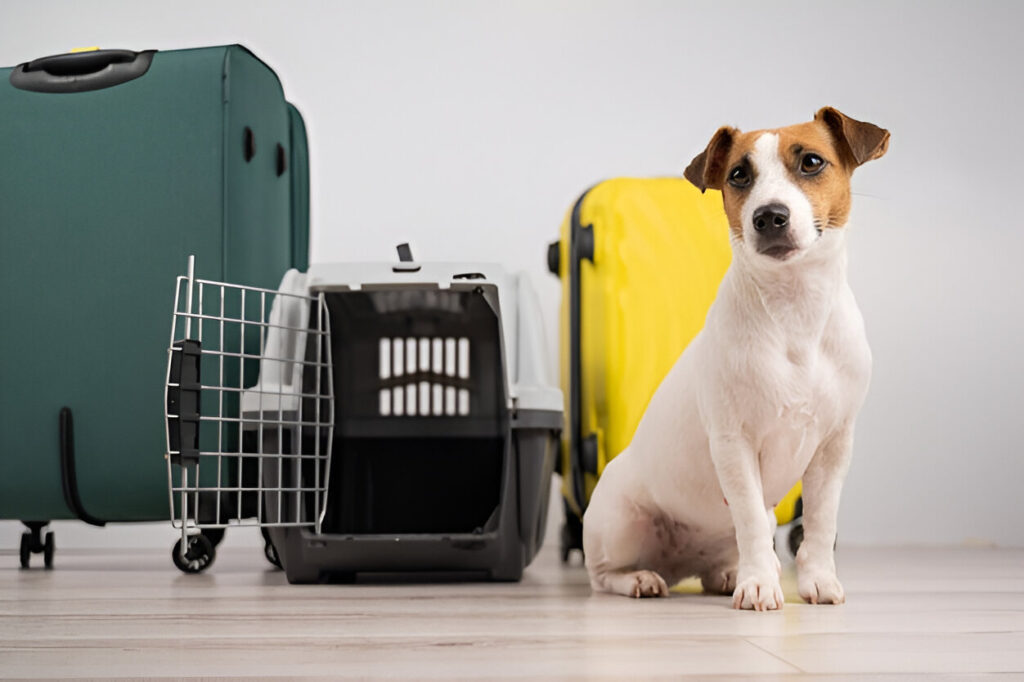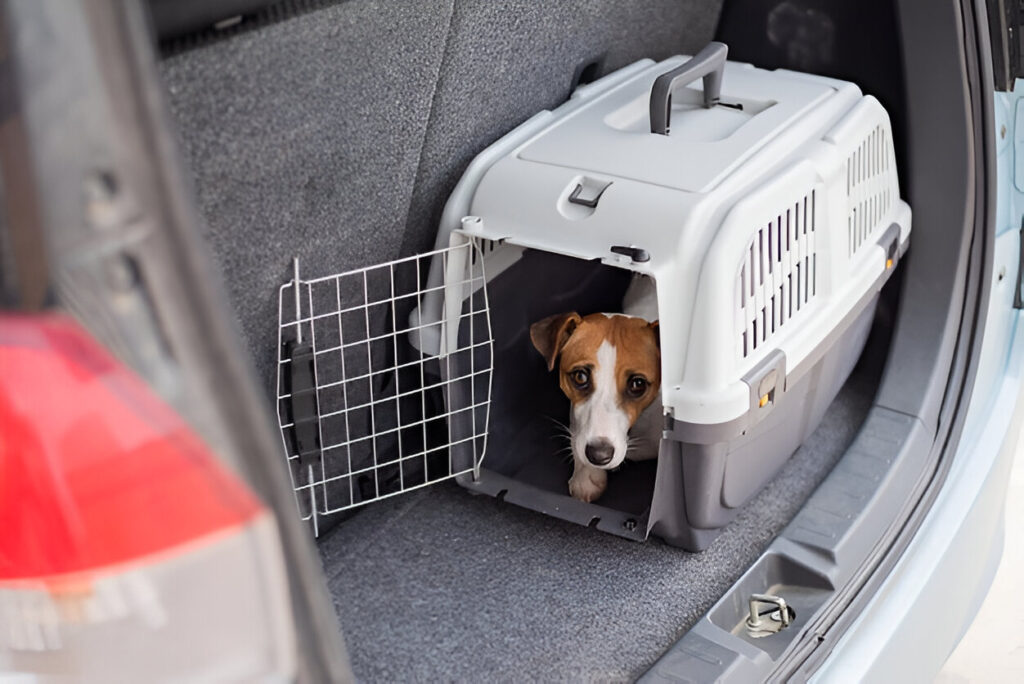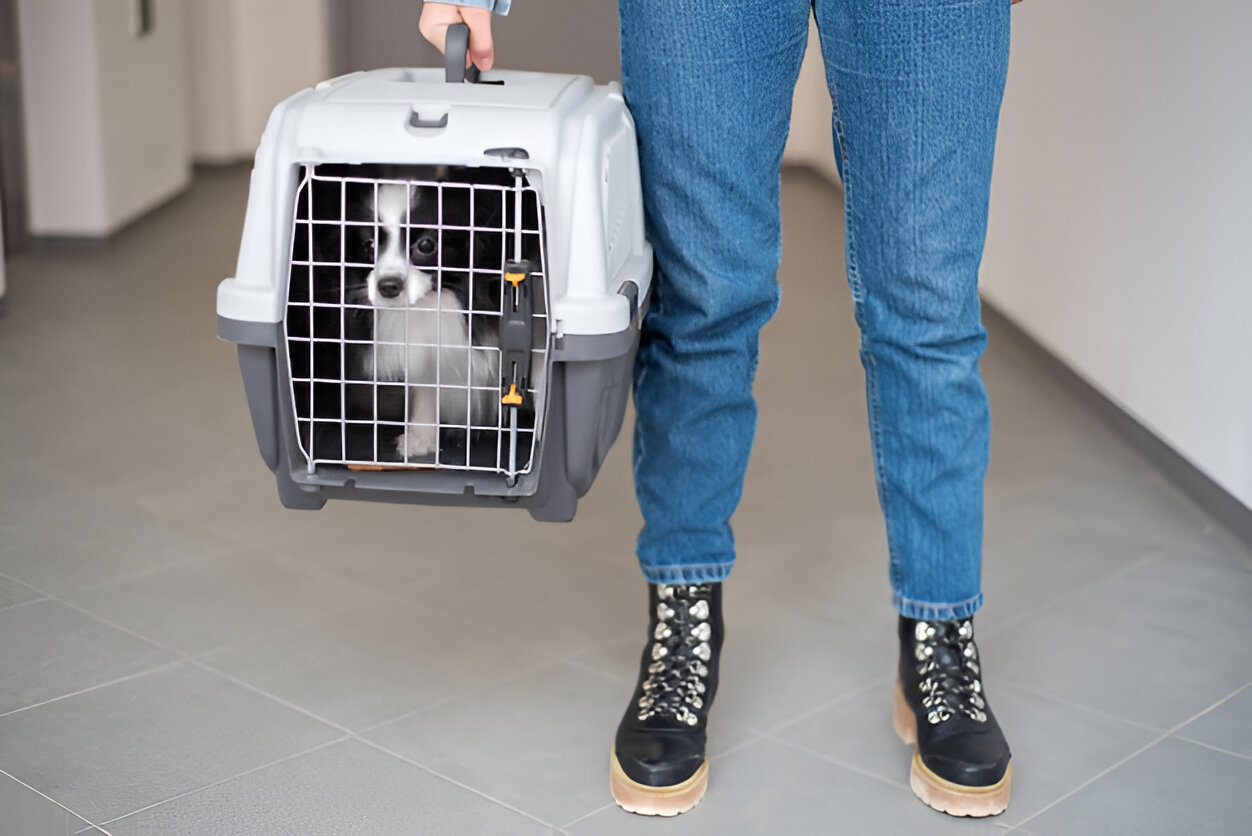Traveling with your dog can be a fun and rewarding experience, but ensuring their safety and comfort is essential. A dog travel crate is one of the most important accessories for pet owners who frequently travel with their furry friends. Whether you’re going on a road trip, flying, or just visiting the vet, a high-quality dog travel crate provides security and peace of mind.
In this comprehensive guide, we’ll explore everything you need to know about dog travels crates, including types, benefits, sizing tips, and how to choose the best one for your pet. For Buy the Crate visit here :

The Ultimate Guide to Choosing the Perfect Dog Travel Crate
Traveling with your furry companion can be an enriching experience, but it requires meticulous planning to ensure their safety and comfort. A dog travel crate is an indispensable tool for pet owners who frequently journey by car, plane, or train. This comprehensive guide will delve into the essentials of selecting, preparing, and utilizing a dog travel crate effectively.
Why a Dog Travel Crate is Essential
A dog travel crate serves multiple purposes:
- Safety: It restrains your dog during transit, preventing injuries.
- Comfort: Provides a familiar space, reducing anxiety.
- Compliance: Meets airline and transportation regulations.
According to the American Kennel Club, using a crate or harness that attaches to the seat belt is crucial for your dog’s safety when traveling.
Selecting the Right Dog Travel Crate
Choosing the appropriate dog travel crate involves considering several factors:
1. Size Matters
The crate should be spacious enough for your dog to stand, turn around, and lie down comfortably. However, it shouldn’t be so large that your pet slides around during travel. Measure your dog from nose to tail and from the floor to the top of their head to ensure a good fit.
2. Material and Durability
- Plastic Crates: Sturdy and easy to clean, ideal for air travel.
- Wire Crates: Offer excellent ventilation, suitable for car travel.
- Soft-Sided Crates: Lightweight and portable, best for small dogs and short trips.
Ensure the crate is free of interior protrusions and has a leak-proof bottom covered with absorbent material.
3. Ventilation
Adequate airflow is vital. Choose a crate with ventilation on opposing sides, with exterior rims or knobs to prevent blocked airflow.
4. Security Features
The crate should have secure latches to prevent accidental openings. For air travel, ensure it complies with International Air Transport Association (IATA) regulations.
Preparing Your Dog for Travel
Acclimating your dog to their travel crate is crucial for a stress-free journey.
1. Introduce the Crate Early
Start crate training several weeks before your trip. Place the crate in a familiar area, allowing your dog to explore it voluntarily. Encourage them with treats and praise.
2. Create Positive Associations
Feed your dog inside the crate to build a positive connection. Gradually increase the time they spend inside with the door closed.
3. Include Familiar Items
Place a favorite toy or a piece of your clothing inside the crate. Familiar scents can provide comfort and reduce anxiety.
4. Practice Short Trips
Take your dog on short car rides in the crate to acclimate them to the motion and environment. Gradually increase the duration to mimic the actual travel time.
Air Travel Considerations
When flying with your dog, additional precautions are necessary:
- Airline Regulations: Each airline has specific requirements for pet travel. Ensure your crate meets their standards.
- Health Certificates: Obtain a health certificate from your veterinarian within 10 days of travel.
- Identification: Label the crate with your contact information and include a “LIVE ANIMAL” sticker.
Road Travel Tips
For car journeys:
- Secure the Crate: Ensure the crate is fastened to prevent movement.
- Comfort: Provide a comfortable bed and keep the car well-ventilated.
- Regular Breaks: Stop every few hours for bathroom breaks and exercise.
Maintaining the Crate
Regular cleaning of the dog travel crate is essential:
- After Each Use: Clean with pet-safe disinfectants.
- Check for Damage: Inspect for any wear and tear that could compromise safety.
Recommended Dog Travel Crates
Here are some top-rated dog travel crates:
- MidWest Homes for Pets iCrate: Easy assembly and practical design.
- Amazon Basics Portable Folding Soft Dog Travel Crate: Durable and affordable.
- Petmate Two-Door Top-Load Pet Kennel: Easy access and airline-approved.
Keeping Your Dog Calm
To reduce anxiety during travel:
- Exercise: Provide ample physical activity before the trip.
- Calming Aids: Consider pheromone sprays or calming treats.
- Avoid Long Flights: If possible, choose shorter flights to minimize stress.
Common Mistakes to Avoid When Using a Dog Travel Crate
Even experienced pet owners can make mistakes when it comes to using a dog travel crate. To ensure a smooth experience, avoid the following common errors:
1. Choosing the Wrong Size
One of the biggest mistakes is selecting a crate that’s either too small or too large. A dog travel crate that’s too small can cause discomfort, while one that’s too large can be unsafe, especially in a moving vehicle. The crate should be just big enough for your dog to stand, turn around, and lie down.
2. Not Crate Training in Advance
Trying to introduce your dog to the crate on the day of travel is a recipe for stress. Proper crate training should begin weeks before the trip. Gradually increasing the amount of time your dog spends in the dog travel crate helps them become comfortable and reduces travel anxiety.
3. Neglecting Ventilation
Ventilation is critical, especially during long trips. Always make sure that the dog travel crate has adequate airflow from multiple sides. Poor ventilation can lead to overheating and respiratory distress.
4. Forgetting to Label the Crate
Especially for air travel, it’s essential to label the crate with your name, phone number, and address. Most airlines also require a “LIVE ANIMAL” label. This simple step can make a big difference in case of any mishandling or loss.
5. Overfeeding Before Travel
Feeding your dog a large meal right before travel can result in nausea and discomfort. It’s advisable to feed your dog 3–4 hours before departure and avoid feeding during travel unless it’s a very long trip. Always provide access to clean water, though.
Travel Crate Tips for Different Dog Breeds
Different breeds have different needs when it comes to selecting a dog travel crate. Below are a few recommendations for various types of dogs:
Small Breeds (Chihuahua, Pomeranian, Yorkshire Terrier)
- Opt for a lightweight soft-sided crate for convenience.
- Choose a crate with a padded interior for added comfort.
- Include a chew toy or small blanket to soothe nervous pups.
Medium Breeds (Beagle, Cocker Spaniel, French Bulldog)
- Choose a crate with both top and front doors for easy access.
- Use a plastic crate for added durability during air travel.
- Ensure proper ventilation and a secure locking mechanism.
Large Breeds (Labrador, Golden Retriever, German Shepherd)
- Invest in a sturdy, hard-sided crate with reinforced sides.
- Make sure the crate is approved by airlines for cargo travel.
- Add a crate mat or orthopedic bed to keep your dog comfortable.
Giant Breeds (Great Dane, Mastiff, Saint Bernard)
- These breeds may require custom-sized dog travel crates.
- Look for crates designed with heavy-duty construction.
- Consult with your airline well in advance for specific regulations.
Alternatives to Traditional Dog Travel Crates
While a dog travel crate is typically the safest and most accepted option for travel, there are a few alternatives depending on your method of transportation and your dog’s behavior:
1. Dog Carriers
Smaller than crates, dog carriers are best for small dogs and short trips. They usually feature a handle or shoulder strap and are more convenient for quick transport.
2. Seatbelt Harnesses
A seatbelt harness can be a viable option for well-behaved dogs during short car rides. However, it doesn’t offer the same level of containment or comfort as a crate.
3. Pet Travel Bags
These soft-sided bags are often airline-approved and suitable for pets that can fit under the seat in cabin class. They’re ideal for small dogs and offer a cozy, confined space.
❗ Note: Regardless of the method you choose, a dog travel crate remains the safest and most recommended option for most situations.
Behavioral Benefits of Using a Dog Travel Crate
Using a dog travel crate isn’t just about safety. It can also positively affect your dog’s behavior:
Reduces Anxiety
Dogs are den animals by nature. A crate provides a secure and familiar environment, reducing stress during new and overwhelming situations like travel.
Encourages Positive Routine
Dogs thrive on routine. By incorporating the dog travel crate into their everyday life, you build a sense of consistency that makes travel less jarring.
Prevents Destructive Behavior
In unfamiliar environments, anxious dogs might chew or scratch. A crate helps limit these behaviors by giving them a designated safe zone.
Traveling Internationally with a Dog Travel Crate
If you’re taking your dog overseas, your dog travel crate plays a critical role in meeting international travel requirements.
Pre-Travel Checklist
- Verify your destination’s pet import policies.
- Ensure your dog travel crate meets IATA standards.
- Get all required vaccines and certifications (e.g., rabies, microchip).
- Contact the airline for pet travel fees and cargo restrictions.
Airline-Approved Crate Requirements
- Must be hard-sided and escape-proof.
- Must have ventilation on all four sides.
- Should include food and water dishes that are accessible from the outside.
- Must be labeled clearly with your contact information and pet’s details.
Tips for Long-Distance Road Trips with a Dog Travel Crate
If you’re hitting the road with your pup in tow, here are some pro tips to make the trip enjoyable:
Stick to Routine
Keep feeding, bathroom, and walk times consistent with your dog’s normal schedule. A well-timed routine keeps them calm and well-behaved.
Clean Regularly
Clean the dog travel crate at every rest stop if needed. Bring disposable pads and wipes for accidents or spills.
Snacks & Toys
Pack your dog’s favorite chew toys or treats to keep them engaged and happy during the journey.
Plan Frequent Breaks
Stop every 2–3 hours to allow your dog to stretch, hydrate, and relieve themselves. It’s essential for their physical and mental well-being.

Crate Maintenance & Storage
Your dog travel crate should be more than a one-time-use item. With proper care, it can last for years.
Cleaning & Sanitation
- Use a mild pet-safe disinfectant after each use.
- Remove and wash any bedding or crate liners.
- Clean water and food bowls thoroughly.
Storage Tips
- For collapsible crates: Fold and store in a dry, cool space.
- For hard-sided crates: Keep them in a garage or storage room with airflow.
- Always check for damage before reusing.
Safety Tips When Using a Dog Travel Crate
While a dog travel crate enhances safety during travel, there are a few extra precautions you should always take:
1. Secure the Crate Properly
- In vehicles, always secure the crate using seat belts or anchoring straps. This prevents the crate from sliding or tipping during sudden stops or sharp turns.
- For air travel, double-check all latches and locks before handing over the crate to airline staff.
2. Avoid Leaving Your Dog Unattended
Never leave your dog alone in a crate in a parked vehicle, especially in warm weather. Even a short period in a hot car can be dangerous or fatal.
3. Monitor Your Dog’s Behavior
Keep an eye on signs of distress, excessive panting, whining, or attempts to escape. If your dog shows signs of severe anxiety, consider consulting a veterinarian or a professional trainer for strategies that can help.
4. Pack an Emergency Kit
Include essential items such as:
- Water and collapsible bowl
- Leash and harness
- Poop bags and cleaning wipes
- Medical records and a first-aid kit
- Treats to calm your dog
How to Choose the Best Accessories for Your Dog Travel Crate
Enhancing your dog travel crate with the right accessories can improve your dog’s travel experience significantly.
Comfortable Bedding
Invest in a soft, washable crate mat or bed. This adds cushioning and helps keep your dog warm on cold surfaces. Look for materials that wick moisture and dry quickly.
Crate Covers
Crate covers can create a den-like atmosphere, which some dogs find comforting. Covers also protect your dog from drafts and reduce outside noise and light distractions.
Food and Water Containers
Use attachable bowls or containers that can be filled from outside the crate, minimizing disruptions during travel. Spill-proof bowls are ideal to avoid messes.
Identification Tags and Labels
In addition to collar tags, attach an ID card or sticker to the crate with your contact info and any special instructions for your dog.
Crate Training: Step-By-Step Guide
Training your dog to accept their dog travel crate positively takes patience and consistency. Here’s a practical plan:
Step 1: Create a Welcoming Space
Place the crate in a room where the family spends time. Add your dog’s favorite blanket or toy inside to make it inviting.
Step 2: Encourage Exploration
Leave the door open and allow your dog to explore freely. Reward them with treats when they approach or enter the crate.
Step 3: Short Confinement Periods
Gradually close the door for a few seconds while offering treats. Slowly increase the time your dog stays inside with the door closed.
Step 4: Feed Meals in the Crate
Feeding your dog in the crate helps create a positive association. Start with the door open and progress to closing the door during meals.
Step 5: Practice Moving with the Crate
Carry or drag the crate a few feet while your dog is inside to get them accustomed to movement.
Step 6: Simulate Travel Conditions
Take short car rides with your dog in the crate to acclimate them to the motion and sounds of travel.
Tips for Flying with a Dog Travel Crate
Flying can be one of the most stressful types of travel for dogs. Here’s how to make it smoother:
- Book Early: Airlines limit the number of pets allowed in the cabin or cargo, so book as soon as possible.
- Direct Flights: Whenever possible, choose direct flights to minimize handling and transit time.
- Arrive Early: Arrive at the airport early to allow plenty of time for check-in and security.
- Avoid Sedatives: Unless prescribed by your vet, avoid sedatives as they may affect your dog’s breathing at high altitudes.
- Monitor Temperature: Check weather conditions at both departure and arrival cities to ensure safe temperatures for your dog.
How a Dog Travel Crate Benefits Your Dog Beyond Travel
Using a dog travel crate is not only helpful during trips but can have ongoing benefits:
- Provides a Safe Haven: Your dog has a personal space to retreat and relax at home.
- Eases Separation Anxiety: Familiarity with the crate can reduce stress when you leave home.
- Facilitates Vet Visits: Many dogs feel safer in their crate at the vet’s office.
- Simplifies Grooming and Training: Crates can be useful tools for managing behavior and routines.
Top Picks: Best Dog Travel Crates for 2025
Here’s an updated list of highly rated dog travel crates based on durability, comfort, and user reviews:
| Crate Model | Best For | Key Features |
|---|---|---|
| MidWest iCrate | Overall Versatility | Foldable, durable, multiple sizes |
| Petmate Sky Kennel | Air Travel | IATA compliant, secure locks |
| Amazon Basics Soft-Sided Travel Crate | Small dogs, light travel | Lightweight, mesh ventilation |
| EliteField Soft-Sided Travel Dog Crate | Portable & Compact | Easy setup, padded interior |
| Frisco Heavy-Duty Wire Dog Crate | Home & Car Use | Rust-resistant, secure door latches |
Frequently Asked Questions (FAQs) About Dog Travel Crates
Q1: Can I leave my dog in the travel crate for long periods?
No. While the dog travel crate is designed for travel and temporary containment, dogs should not be confined for extended hours without breaks, exercise, food, and water.
Q2: Are soft-sided crates safe for flying?
Soft-sided crates are generally not allowed for cargo travel but may be accepted in the cabin for small dogs. Always check airline policies before flying.
Q3: How do I measure my dog for the right crate size?
Measure your dog standing up from nose to base of tail and from the floor to the top of their head or ears (whichever is higher). Add a few inches for comfort.
Q4: How often should I clean the dog travel crate?
Clean the crate after every use. For frequent travelers, a weekly cleaning schedule is recommended to maintain hygiene.
Q5: Is crate training necessary for all dogs?
While not mandatory, crate training is highly beneficial to ease travel stress and keep your dog safe.





